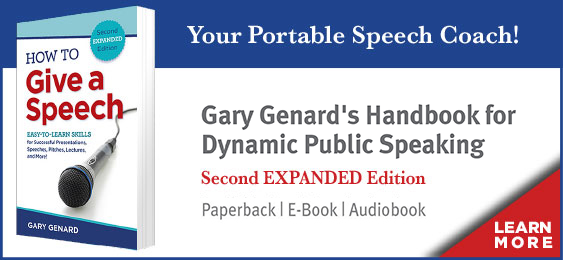Getting ready to deliver an important speech, pitch, or business presentation? Here are some sobering findings for you. Together, they serve as a reminder that great speaking techniques aren't enough. You'd better be ready to plan carefully and well as a business speaker to get listeners to retain what you say.
At Public Speaking International, we make audience engagement and the retention of information a key element of planning and delivering a business presentation. (If you're using PowerPoint, be sure to download our cheat sheet "5 Rules for Succeeding with PowerPoint.")
- Claudyne Wilder in The Presentations Kit informs readers that audience members listen with a low level of efficiency. So they need to be told things three times, given the fact that they distort 40-60 percent of what they hear.[1]
- According to research by Michael Aun, an audience’s retention is strongly tied to the use of visual aids. Following a speech given with no visual reinforcement, for instance, listeners retain only about 10 percent of information. If visuals such as slides, charts, props, etc., are added, retention rises to 60 percent. And if a handout is included, the amount of information retained leaps up to 85 percent.[2]
- And Stephen C. Rafe warns that audiences are easily bogged down by too much information. One or two key points can be managed well enough by the average listener. But once you’ve introduced, say, five major thoughts, your listener is juggling no less than 120 different ways of relating the different bits of information![3]
If You Retain One Thing as a Presenter, It Should Be This
The three-part lesson you should take away from these findings is clear:
Your best bet for getting listeners to retain information is to offer one major idea supported by evidence. Repeat this theme more than once, in different ways. And be sure to include visual reinforcement.
Anything else you should do to help your audience out? Obviously, retention will be aided if you begin this process at the start of our presentation, and remember it at the end of your speech as well. That's closely tied to the rhetorical concepts of primacy and recency, which state that audiences will retain best what they experience first and last.
By combining that knowledge with the key points above concerning how audiences retain information, you'll have a good chance of making a lasting impact on the hearts and minds of your listeners.
Need Some Proof?
Apart from the expert advice given above and the footnotes cited below, what about some proof you can relate to? Do you yourself retain anything from speeches or presentations you've heard lately?
To make it a bit easier, let's look at highly public examples. What do you retain from the last three or four State of the Union speeches you've heard? Nothing, right? Why? Too many themes and talking points to remember! But we remember one or two great things from JFK or Lincoln's inaugurals, or Martin Luther King's most famous speech.
Are visual aids really effective? Well, have you noticed how American flags have proliferated on stage when politicians speak? One or two used to suffice; now, there are likely to be a dozen behind the speaker. Of course, when used well one good visual is enough. Picture in your mind's eye Steve Jobs on stage. Isn't he holding up a certain iconic phone for all to see?
Finally, I'm sure you've noticed that the advice in this article have been given to you three times: in the expert opinions cited, in my own "three-part lesson" indented above, and once again in this concluding section on proof from your own experience. Will any of it stick with you after you've finished reading? Hope so!
Key takeaways from this blog:
- Audiences don't listen closely, so repeat your key message at least 3 times.
- Visual aids will strongly help information retention.
- Emphasize one or two key points. More will make your listeners juggle!
_________________
[1] Claudyne Wilder, The Presentations Kit (New York: John Wiley & Sons, 1994), vii.
[2] Jeff Slutsky and Michael Aun, The Toastmasters International Guide to Successful Speaking (Chicago: Dearborn Financial Publishing, 1997), 77.
[3] Stephen C. Rafe, How to Be Prepared to Think on Your Feet (New York: Harper Business, 1990), quoted in Lilly Walters, Secrets of Successful Speakers (New York: McGraw Hill, 1993), 59.



